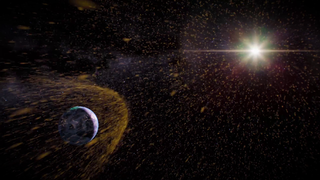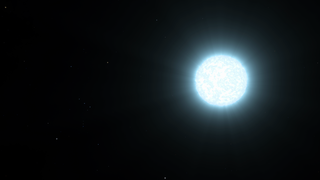Universe
ID: 13852
NASA’s upcoming Nancy Grace Roman Space Telescope will see thousands of exploding stars called supernovae across vast stretches of time and space. Using these observations, astronomers aim to shine a light on several cosmic mysteries, providing a window onto the universe’s distant past and hazy present.
Roman’s supernova survey will help clear up clashing measurements of how fast the universe is currently expanding, and even provide a new way to probe the distribution of dark matter, which is detectable only through its gravitational effects. One of the mission’s primary science goals involves using supernovae to help pin down the nature of dark energy – the unexplained cosmic pressure that’s speeding up the expansion of the universe.
Roman will use multiple methods to investigate dark energy. One involves surveying the sky for a special type of exploding star, called a type Ia supernova.
Many supernovae occur when massive stars run out of fuel, rapidly collapse under their own weight, and then explode because of strong shock waves that propel out of their interiors. These supernovae occur about once every 50 years in our Milky Way galaxy. But evidence shows that type Ia supernovae originate from some binary star systems that contain at least one white dwarf – the small, hot core remnant of a Sun-like star. Type Ia supernovae are much rarer, happening roughly once every 500 years in the Milky Way.
In some cases, the dwarf may siphon material from its companion. This ultimately triggers a runaway reaction that detonates the thief once it reaches a specific point where it has gained so much mass that it becomes unstable. Astronomers have also found evidence supporting another scenario, involving two white dwarfs that spiral toward each other until they merge. If their combined mass is high enough that it leads to instability, they, too, may produce a type Ia supernova.
These explosions peak at a similar, known intrinsic brightness, making type Ia supernovae so-called standard candles – objects or events that emit a specific amount of light, allowing scientists to find their distance with a straightforward formula. Because of this, astronomers can determine how far away the supernovae are by simply measuring how bright they appear.
Astronomers will also use Roman to study the light of these supernovae to find out how quickly they appear to be moving away from us. By comparing how fast they’re receding at different distances, scientists will trace cosmic expansion over time. This will help us understand whether and how dark energy has changed throughout the history of the universe.
NASA’s Roman Mission to Probe Cosmic Secrets Using Exploding Stars
Roman’s supernova survey will help clear up clashing measurements of how fast the universe is currently expanding, and even provide a new way to probe the distribution of dark matter, which is detectable only through its gravitational effects. One of the mission’s primary science goals involves using supernovae to help pin down the nature of dark energy – the unexplained cosmic pressure that’s speeding up the expansion of the universe.
Roman will use multiple methods to investigate dark energy. One involves surveying the sky for a special type of exploding star, called a type Ia supernova.
Many supernovae occur when massive stars run out of fuel, rapidly collapse under their own weight, and then explode because of strong shock waves that propel out of their interiors. These supernovae occur about once every 50 years in our Milky Way galaxy. But evidence shows that type Ia supernovae originate from some binary star systems that contain at least one white dwarf – the small, hot core remnant of a Sun-like star. Type Ia supernovae are much rarer, happening roughly once every 500 years in the Milky Way.
In some cases, the dwarf may siphon material from its companion. This ultimately triggers a runaway reaction that detonates the thief once it reaches a specific point where it has gained so much mass that it becomes unstable. Astronomers have also found evidence supporting another scenario, involving two white dwarfs that spiral toward each other until they merge. If their combined mass is high enough that it leads to instability, they, too, may produce a type Ia supernova.
These explosions peak at a similar, known intrinsic brightness, making type Ia supernovae so-called standard candles – objects or events that emit a specific amount of light, allowing scientists to find their distance with a straightforward formula. Because of this, astronomers can determine how far away the supernovae are by simply measuring how bright they appear.
Astronomers will also use Roman to study the light of these supernovae to find out how quickly they appear to be moving away from us. By comparing how fast they’re receding at different distances, scientists will trace cosmic expansion over time. This will help us understand whether and how dark energy has changed throughout the history of the universe.
Used Elsewhere In
Source Material
For More Information
Credits
Scott Wiessinger (USRA): Producer
Ashley Balzer (ADNET Systems, Inc.): Science Writer
Adriana Manrique Gutierrez (USRA): Lead Animator
Claire Andreoli (NASA/GSFC): Public Affairs Officer
Barb Mattson (University of Maryland College Park): Narrator
Scott Wiessinger (USRA): Animator
Scott Wiessinger (USRA): Writer
Scott Wiessinger (USRA): Editor
Ashley Balzer (ADNET Systems, Inc.): Science Writer
Adriana Manrique Gutierrez (USRA): Lead Animator
Claire Andreoli (NASA/GSFC): Public Affairs Officer
Barb Mattson (University of Maryland College Park): Narrator
Scott Wiessinger (USRA): Animator
Scott Wiessinger (USRA): Writer
Scott Wiessinger (USRA): Editor
Please give credit for this item to:
NASA's Goddard Space Flight Center
NASA's Goddard Space Flight Center
Short URL to share this page:
https://svs.gsfc.nasa.gov/13852
Mission:
Nancy Grace Roman Space Telescope
This item is part of these series:
Narrated Movies
Astrophysics Features
Keywords:
SVS >> Galaxy
SVS >> Astrophysics
SVS >> Universe
SVS >> Space
SVS >> Binary Star
SVS >> Supernova
SVS >> Dark Energy
SVS >> Star
NASA Science >> Universe
SVS >> Nancy Grace Roman Space Telescope
https://svs.gsfc.nasa.gov/13852
Mission:
Nancy Grace Roman Space Telescope
This item is part of these series:
Narrated Movies
Astrophysics Features
Keywords:
SVS >> Galaxy
SVS >> Astrophysics
SVS >> Universe
SVS >> Space
SVS >> Binary Star
SVS >> Supernova
SVS >> Dark Energy
SVS >> Star
NASA Science >> Universe
SVS >> Nancy Grace Roman Space Telescope













